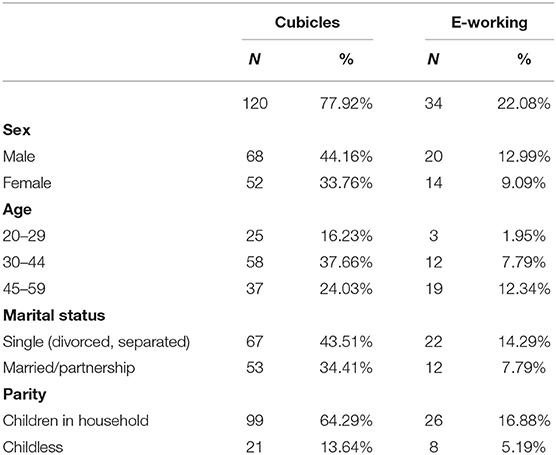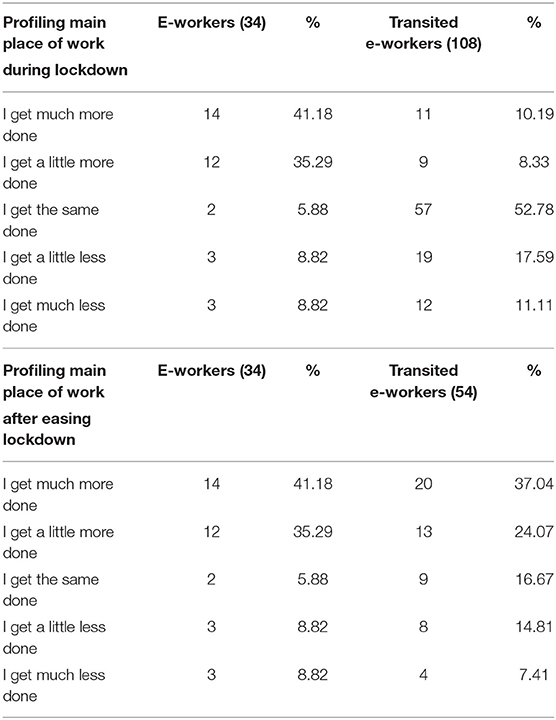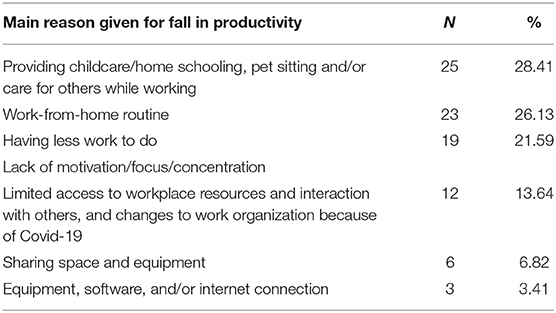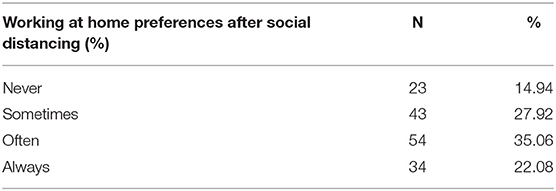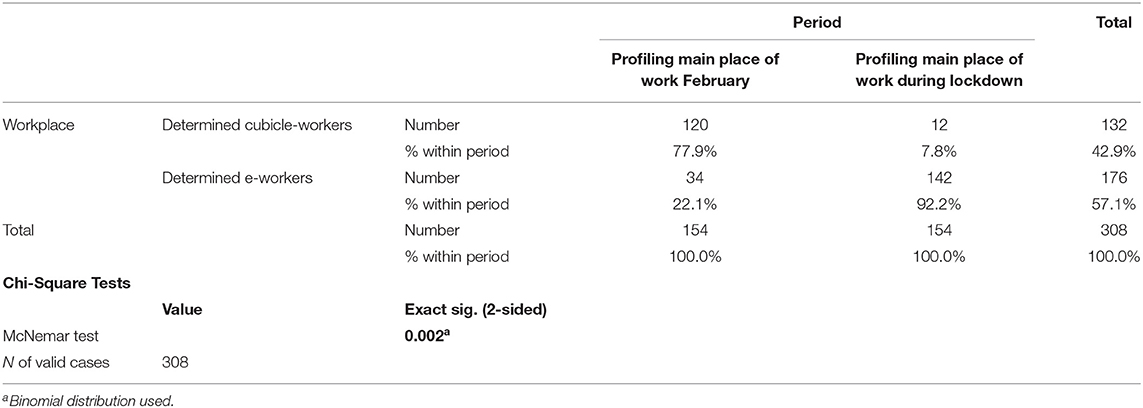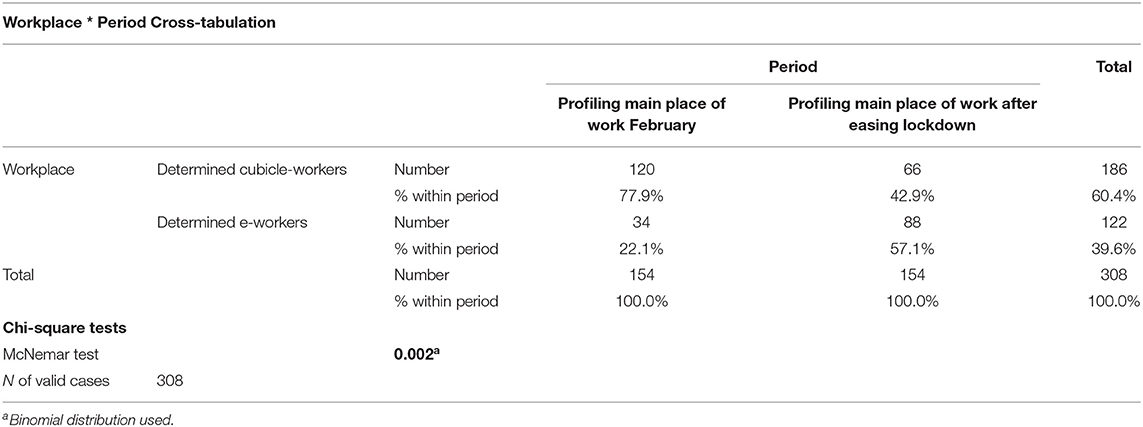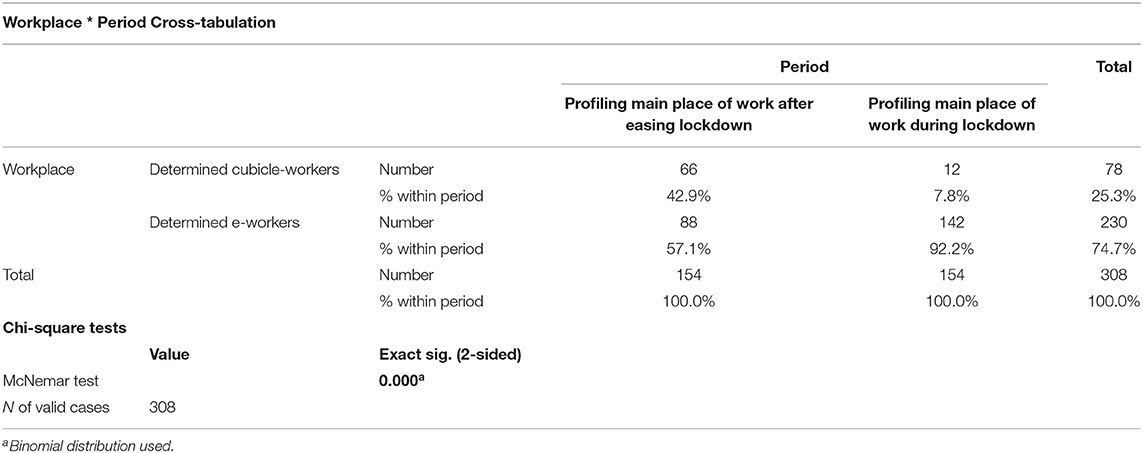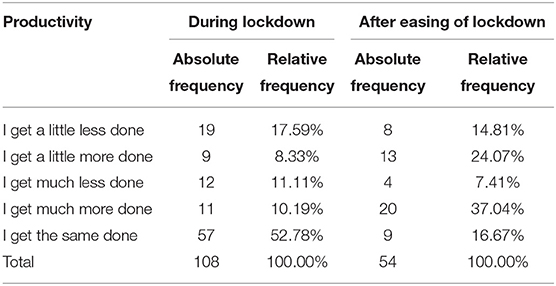- Faculty of Business Strategy, Institute of Technology and Business in Ceske Budejovice, Ceske Budejovice, Czechia
The Covid-19 crisis across the world has increased the proportion of e-working. The transition from cubicles to the home office raised many questions in connection with companies adopting the new working conditions. Our paper provides recent evidence on the extent of this move, its impact on workplace evolution, productivity and the future prevalence of the face-to-display workplace after the easing of the lockdown. It uses data from 154 service employees of an Austrian sports and leisure product company obtained using online surveys on employees' opinions on e-working. By a coincidence, we conducted the first of them shortly prior to the epidemic. We decided to modify our planned research goals and decided to study their opinions during different Covid-19 stages. As a result, our findings do not follow all the academic standards. First, they are almost impossible to replicate due to the specific coincidence. Then, the shift in our aims leads us to minor changes in the content of the questionnaire. There are not only significant differences in the proportion of workers in the office and at home during the different periods of the lockdown. After its end, there was a significant increase in the number of those who had started working at home—more than one half. Compared to the period prior to the lockdown, they have a tolerant attitude to their work from home and believe that their productivity might remain the same. For many of them the change was an unavoidable obligation so they would prefer to return to the traditional workplace. The results suggest that more than one fifth want to continue working from home permanently, about one third more frequently than before, more than a quarter sometimes and just one seventh not at all. We studied the issues related to their productivity and its limits during all three stages. There are three important reasons for the fall in productivity related to e-working: (1) Providing childcare/home schooling, pet sitting and/or care for others while working (>one-fourth); (2) Work-from-home routine (>one-fourth); and (3) Having less work to do (>one-fifth).
Introduction
Covid-19 had spread worldwide by the first weeks of 2020 and was declared a pandemic in March 2020 (WHO, 2020). Reducing face-to-face contacts is an important action to mitigate its impact (ILO, 2020). According to Baldwin and Weder di Mauro (2020), the Covid-19 economic crisis has been an unprecedented shock for the European economy and society, and it requires swift policy action and a coordinated fiscal response. Many governments enforced regional lockdowns. The Austrian government responded by requesting people to refrain from leaving their homes and by encouraging e-working wherever possible (OTS, 2020). Companies were forced to increase their remote work. With a figure of 9.9%, Austria had a high percentage of telework among the countries of the European Union in 2019 (Eurostat, 2020a). Despite widespread promotion by the government and organizations in recent years, the utilization rate of telework has remained stable (Eurostat, 2020a). The European figures are rather low. Blinder (2009) estimated the upper limit of jobs in the US that could potentially be done offshore in 2004 at between 22 and 29%. In 2013, all measures found that roughly 25% of US jobs can be done offshore (Blinder and Krueger, 2009). In a recent study, the authors' classification shows that 37% of US jobs can plausibly be performed at home (Dingel and Neiman, 2020).
The epidemic launched an e-working experiment across the world. Prior to it, the home office was only used by a few individuals or small groups in 75% of Austrian companies. The situation has changed suddenly. A total of 90% of those surveyed stated that at least half of the workforce worked from home during the lockdown (Deloitte, 2020). In nearly 60% of companies, almost all employees worked from home. Among the companies that took part in the survey, 96% used home offices intensively during the lockdown (Deloitte, 2020). Across the European Union, over a third (33.7%) reported working exclusively from home during the pandemic (Eurofound, 2020). Furthermore, Brynjolfsson et al. (2020) found that about half of US employees are now working from home, including 35.2% who reported they were previously commuting, but recently switched to working from home. Their survey estimates that the share of remote workers in the US has quadrupled to nearly 50% of the nation's workforce. In the past, e-working was a privilege for a select few. In this crisis, however, it has become a necessity and an established way of working. The factors that drive e-working are long commuting times, the rise of gig-economy employment opportunities, work-life-balance demands and the spread of Covid-19.
Telecommuting, virtual office, and telework are a few of the terms used to describe the same phenomenon (Siha and Monroe, 2006) with different dimensions, e.g., duration, schedule, location, task, synchrony, voluntariness, ICT, contract (Allen et al., 2015; Nicklin et al., 2016) and Covid-19. E-working is a method of working by making use of information and communications technology (ICT) in a situation in which the work is not bound to any particular location. Traditionally this has been understood as working away from the office, usually at home, either full-time or for part of the working week (WDC, 2017). In our study, e-working (face-to-display workplace) is where employees work at home full-time/part-time, on a hybrid basis or at a different place or virtually. In brief e-workers are those workers who, in the time of Covid-19, are working outside the organization's premises using modern technology.
Disagreement over the performance of remote employees has received widespread attention in recent years. Some argue that working from home allows employees to be more productive due to fewer office distractions, while others disagreed and maintained that the home is not the best environment because it is subject to home distractions (Fonner and Roloff, 2010). Bloom et al. (2015) found that call-center workers at a large Chinese travel agency randomly assigned to work from home 4 days a week for 9 months increased their performance by 13% compared with those who stayed in the office. Work-from-anywhere arrangements could be even better for productivity than working from home, depending on the type of work (Choudhury et al., 2019). However, Battiston et al. (2017) revealed in a natural experiment that the physical proximity of workers in the same office improves productivity through better face-to-face communications. Dutcher (2012) found, on the basis of a laboratory experiment, that a telecommuting environment may have positive effects on productivity for creative tasks but negative effects on productivity for dull tasks. Generally, e-working makes employees happy, and satisfied employees are usually more productive.
The widespread demand for e-working, the significant policy drivers and the increase of its utilization during Covid-19 have emphasized the need for real-life evidence. Our research was conducted by means of online surveys. It addressed the following research questions:
• RQ1: Is there a difference of proportion between cubicle workers and transited e-workers (i.e., those who were not working online prior to the pandemic)?
• RQ2: What impact has e-working had on the productivity of face-to-display workers?
• RQ3: What may cause falling productivity at home?
• RQ4: The pandemic has accelerated the implementation of e-working—will it last?
It is important to say they the fourth question was added during the research. Our initial aim was to study just the first three only. As the pandemic critically affected all participants and they had to move to their home offices, we were interested whether this experience would affect their future and how.
The following section provides an account of the concept of workplace productivity. The third briefly outlines the methodology used in this research. The fourth section gives an overview of our results. Then follows a section presenting our discussion, and the last section gives the conclusions.
Theoretical Background
Workplace flexibility, the digitisation of work, the increased blurring of boundaries between work and private life, modern ICT, the global economy and the Covid-19 crisis, all these developments will continue to affect every part of our social and economic life. The investigation of these factors started years before the pandemic.
Evans et al. (2004, p. 2) define flexibility in the employment relationship as “ceding control to workers over the circumstances of their work by enabling them to vary those circumstances to address personal and family needs and uncertainties.” Flexibility generally covers temporal flexibility (flexitime, nine-day fortnights), spatial flexibility (how the physical work space is designed and used) and geographic flexibility (where the work is done). E-working is one of a number of possible work practices of this kind. Currently, it is the most preferred, effective and complete among them as it incorporates many elements of temporal, spatial and geographic flexibility.
Taylor (1911) argued that the best way to boost productivity was to embrace three rules: break complex jobs down into simple ones, measure everything that workers do and link pay to performance, giving bonuses to high-achievers and sacking sluggards. Digital Taylorism seems to be a more powerful tool than its analog predecessor (Schumpeter, 2015) because every move of e-workers can be easily controlled by dedicated software. With the demands on the modern workplace generally rising, Moore (n.d.) highlights “businesses are faced with a wealth of new external and internal drivers to force managers to provide a workplace that supports business objectives while providing employees with an environment where they want to work and that will allow them to be at their most productive.” From this point of view, e-work is also a way of diminishing the stress that is often prevalent in today's workplace. Stress and excessively long working hours contribute to the deaths of ~2.8 million workers every year (ILO, 2019). This is also confirmed by a study by Sayah and Süß (2013), which illustrates that the work-life conflict of contract workers is significantly influenced by working hours and income. Research shows that changes in working conditions can provoke conflict between work and private life (Byron, 2005). The extractive approach, which treats people and planet merely as resources waiting to be exploited for profit, does not represent the current situation.
Productivity is commonly defined as a ratio between the output volume and the volume of inputs (OECD, 2020). The productivity of workers could thus be measured as an output, e.g., sales or units produced, relative to an input, e.g., the number of hours worked or the cost of labor. Traditionally, labor productivity is derived from aggregate measures at the firm level, e.g., value added per worker (Sauermann, 2016). Further, Pritchard (1992, p. 455) defines productivity as follows: “. how well a system uses its resources to achieve its goals.” With this definition, productivity is a combination of both efficiency and effectiveness. Productivity as a term is closely related to both performance and effectiveness (Jayamaha and Mula, 2011). While performance and effectiveness relate to the employees' ability to perform in accordance with what is expected of them and measures their output in terms of quality, productivity takes the cost of achieving performance or effectiveness into account (Jex and Britt, 2014). While productivity increase is a benefit for the individual employee, because it improves efficiency (for example, it removes distractions and reduces time spent commuting), it has also shown evidence of increasing the productivity of output, i.e., performance, and thus generating a beneficial productivity increase for the organization; Nilles believes that telework on average increases the productivity of employees by 5–20% (Nilles, 1997).
Generally, productivity depends on several factors that affect the employee's productivity levels. Todays' e-workers have a wide range of choices on how, when and where their work will be done. Several studies have investigated the impact of e-working on productivity (Dutcher, 2012; Laihonen et al., 2012; Bloom et al., 2015; Gambardella et al., 2015; Battiston et al., 2017; Beno, 2018; Iazzolino and Laise, 2018; Palvalin, 2019). Generally, team productivity is different from individual productivity. Some studies analyzed the relationship between working from home and employees' productivity. The results revealed a positive effect on employees' productivity (Bailyn, 1988; Olson, 1989; Dubrin, 1991; Hill et al., 1998; Bélanger, 1999). Further research investigated the influence of working from home on employees' productivity; data from laboratory or field experiments were used in order to estimate the positive causal effect of working from home on employees' productivity (Dutcher, 2012; Bloom et al., 2015). Peters et al. (2004) find that organizations rank productivity and work quality problems second among the drawbacks of working from home. Monteiro et al. (2019) suggest that remote work has a significant negative effect on labor productivity, though the productivity loss is relatively modest in magnitude (around 2.3%).
Data and Methodology
Data Collection
The current e-working framework in our examined company (an Austrian sports and leisure product company) was implemented 10 years go with its policies and practices, and the setting up and monitoring of results. E-working enabled the organization to drive down their cost base and increase the engagement of their people. To be eligible, employees had to put their request for e-working to their manager. The number of these approvals was 34 out of total 250 employees.
The preparation of our research started prior to the epidemic. As a large proportion of the workers had had some experience of home-office working, our initial aim (RQ1) was to investigate whether there was a difference of proportion between cubicle workers and transited e-workers (i.e., those who were worked online occasionally). We wanted to learn whether there is any impact from e-working on the productivity (RQ2) as well as what may cause falling productivity at home (RQ3).
The questionnaire was pre-tested by a selected group of 12 employees.
After its revision, our first questionnaire was emailed to all employees and completed by 154 (response rate 61.6%). To get a realistic picture, we wanted to cover at least 20% of their current working week. For that reason, all 34 employees who were already working were invited to participate.
Email notifications were sent to all employees in order to inform them of the questionnaire, its purpose, dates, etc. A total of 154 employees participated in the survey (including the 12 pre-testers). For the study of work/e-work productivity, the following criteria were used in our final selection:
• All were workers in the service sector;
• All had some experience with e-working;
• Due to the presumed long-term study, all agreed to participate in all the rounds of the survey (the current and next ones).
The group consisted of 34 e-workers (20 male and 14 female) and 120 cubicle workers (68 male and 52 female). The sample was a heterogeneous group of professionals working in several areas, including customer services, accounting, electronic data processing, research and development, marketing and logistics.
Our research was carried out using a quantitative approach. The first survey was run on 28 February 2020—before the extent of the pandemic was recognized. Responses to the questionnaires were anonymous. The questions of the survey covered an agreed set of topics (such as job satisfaction, technology, working patterns, etc.) and demographic information. Characteristics of the survey respondents, such as gender, age, marital status, parity, and official homeworking status were included under the presumption of their relevance to their personal position toward e-working (see Table 1).
The groups are similar in all parameters except one—their age. The distribution indicates a higher age among e-workers than among cubicle workers. The age difference is presumably caused by the necessity to mentor less experienced employees; the more experienced ones are given more freedom. This explanation fits well with the traditional view of management, and with our original aim, which was designed and developed to provide a better understanding of workplace changes and employee productivity in on-line and on-site working conditions. For this reason, we opted for cubicle workers and e-workers who had some experience of e-work prior to our research (see Table 2). The reason for this requirement was so that respondents were capable of responding to and discussing the issues of e-work productivity.
Suddenly, the situation changed. Due to the pandemic, all participants had to respect restrictions. As a result, additional questions addressing RQ4 were added to reflect the spread of Covid-19. This extended version was then run during the lockdown (31 March 2020) and after it was eased (29 May 2020). Table 2 shows a sudden jump in the February and March figures. The size of the increase demonstrates the effect of the lockdown. The difference between February and May is more interesting. The number of e-workers more than doubled. Further research will have to be done after the epidemic is over in order to determine the future impact on the face-to-display workplace in the company.
Tables 3, 4 relate to productivity and deal with possible cases of a fall in productivity among e-workers. The scale of responses comparing productivity at the end of March and at the end of May were as follows: I get much more done, I get a little more done, I get the same done, I get a little less done, and I get much less done. In the final stage of the survey, respondents were also given the choice of a number of possible reasons for the fall in productivity.
In the May survey, we included another question about the future prevalence of the face-to-display workplace after the easing of the lockdown (see Table 5). The last added question (RQ4) was: After the easing of the lockdown, how often would you like to work from home? The response choices were: never, sometimes, often and always.
There is a reliability risk with e-mail questionnaires because it is more difficult to guarantee anonymity, and respondents may have concerns that the information they provide may be misused. To assure them that this would not happen, the authors of the paper proceeded in the following manner. First, the anonymity of their responses was emphasized in the questionnaire invitation. There was also a description of the procedure that was then followed. We used trusted software that did not allow linking identifiers with their responses. Their personal information and responses were stored in separate files. And then the authors made certain that all IP addresses, e-mail data and other personal data were not archived.
Data Analysis
In the first stage, we used cross-tabulation of data to examine relationships within the data. In the second stage of our analysis, we used the McNemar test to determine the consistency in the responses across two variables. We tested two workplace moves to determine whether there is a significant difference between the proportion of workers working from home and those working from cubicles in all three examined periods. In the next step, we examined productivity. We used Pearson's chi-square test to determine whether there is a difference between the productivity of e-workers during and after the lockdown.
Findings
The following paragraphs provide an overview of the findings from the quantitative component of the research study. Austria traditionally has low levels of unemployment and high social standards. Increased ICT has given rise to new forms of employment in Austria and throughout Europe (Eu2018at, 2018). According to Eurostat data (Eurostat, 2020b), the Netherlands topped the list of EU member states for the number of people working from home, closely followed by Finland (13.3%), Luxembourg (11.0%), and Austria (10.0%). The lockdown restrictions imposed by the Austrian government led to a rapid growth of e-working.
In our investigated company, work carried out in cubicles (77.92%) exceeded the rate for e-workers (22.08%) before the lockdown. During the lockdown, the proportion changed dramatically in favor of e-workers (cubicles−7.79% to e-workers−92.21%), and after the easing of the lockdown the proportion became more balanced (cubicles−42.86% to e-workers−57.14%). See Table 3. This was possible due to excellent technological connectivity, which according to Messenger and Gschwind (2016) facilitates the process, since it allows work to be done anywhere and at any time. Data collected before the lockdown show that e-working was more prevalent among male employees, whereas during and after the lockdown it became a necessity for everybody. This confirms Beno's (2019) survey data that telework is a male-dominated working method. Nearly 4 in 10 people in the EU began working from home as a result of the Covid-19 pandemic (Eurofound, 2020).
To answer the first research question (RQ1), we examined the outcome data statistically with the assistance of the McNemar test. In this first question, we used pre-, during and post-lockdown data to find out whether employees worked at home or not. All p-values (marked in yellow, see Tables 6–8) of the McNemar test are below the significance level of 0.05. According to the data, there were considerable differences in the proportion of workers in the office and at home during all three periods. Over the course of the surveyed periods, the e-working proportion increased on average by 57.14%. Briefly, this surge in e-working occurred during the lockdown (92.21%).
Employers expected about 44% of workers to start working from home during the pandemic; 78% of business leaders think hybrid and home-working will have a negative impact on productivity (WEF, 2020). In the midst of the Covid-19 crisis, e-working became a lifesaver for all employees who could do this kind of work. Then a question appeared: Would the sudden and dramatic increase of e-working make the workers more productive or not? Bloom et al. (2015) found that a company's staff became notably more productive by working from home 4 days a week. Recent results from a Canadian survey suggest that one third of respondents said they feel that their productivity has increased since they started working remotely—this despite the fact that more than half the participants in the study are working with another person at home (Udemnouvelles, 2020).
Our evidence, using Pearson's chi-square, suggests that after the lockdown there was a significant increase in the number of transited home-centered workers (those who had just started working at home) who had done a little more or much more than during the lockdown. The biggest difference is for workers with long experience who claim that their labor productivity did not change in any period. During the lockdown this applied to more than half of the workers, whereas after the lockdown it was only a third of the workers who continued working at home (after previously working in an office) as shown in Table 9. Apparently, those who do not feel comfortable with e-work tend to be less productive.
The P-value (1.64396) is lower than the chosen level of knowledge; we reject the null hypothesis of independence. The periods before and after the lockdown show a significant impact on labor productivity. These periods also differ markedly in three categories: I get a little more done, I get much more done and I get the same done.
What causes productivity to fall at home? There are three important reasons for the fall in productivity related to e-working: (1) Providing childcare/home schooling, pet sitting and/or care for others while working (28.41%); (2) Absence of work-from-home routine (26.13%); and (3) Having less work to do (21.59%). There is no magic formula. What employees should do to maintain a good balance of productivity and happiness while working from home depends on their own personality and probably on their individual time management.
The last research question related to the future prevalence of the face-to-display workplace after the easing of the lockdown. The May 2020 survey asked respondents how often employees would like to work from home after the end of social distancing. The results suggest that more than one fifth (22.08%) want to continue working from home always, more than one third (35.06%) often, more than a quarter (27.92%) sometimes and just over one seventh (14.94%) not at all.
Discussion
The pandemic has changed our working opportunities and habits. It affects all five generations included in the production processes: traditionalists (born prior to 1946), baby boomers (born between 1946 and 1964), Gen X (born between 1965 and 1976), Millennials, also called Gen Y (born between 1977 and 1997) and iGeneration born after 1997. They all have to find their new workplaces on the Internet.
This allows us to define Workplace 5.0 as a multigenerational workplace continuity in management and supervisory practice which are important for success in supporting multiple generations (Yang and Guy, 2006). Clearly, there would be similarities as well as differences between them. The term “period war of talent” was coined in 1997 and refers to the changing landscape at the workplace to attract and retain talent. Since then, the situation is becoming more challenging. Nowadays, it is very hard to fix the borders since it also depends on personal mindsets. For those who come through the current crisis reasonably well, the economic aspect will be the most important. More than ever, the reduction of costs will be the main focus and will play a central role in the context of Workplace 5.0. Covid-19 brought a completely new, previously unseen aspect: social distancing (including the tightening of hygiene restrictions). E-working and the home office are not just a solution to a crisis, they will be essential components of the future style of work.
This implies that the focus on the post-Covid-19 workplace will be determined by the following formula:
where:
C stands for cost reduction;
S stands for the necessity to maintain a social distance; and
E stands for e- and hybrid working, i.e., the possibility to work regardless one's location.
At the same time, there are no adequate tools to measure employee productivity, task completion and timeliness (Joice, 2000). That is why our research has concentrated on the employee's personal feelings about his/her productivity. As a minimum, such subjective evaluation can express to what degree the person's productivity differs from its “standard.” Any deviation will affect the productivity of the company as a whole.
However, it has been said that measuring productivity is not as important as measuring the quality of its outcome. Managers need to develop a way to measure both (Joice, 2000). The ability to evaluate an employee's productivity is important, because it relates to the possibility of promotion, compensation and more (Baffour and Betsey, 2000). Again, individual evaluations do not solve the problem, but can serve as a benchmark for decisions whether to make a transfer to home office, with whom and to what degree.
How do employers measure the productivity of e-workers and co-located workers in an e-economy? The basic formula for productivity, namely output divided by input, measures production (output) over a set period of time (input). Can we implement a similar formula for e-working? What is it that is being produced in e-working? Is input (time) important? In unskilled work, the task obviously is, but in e-working this is rarely the case. We cannot remove the human aspect from work and productivity. A satisfied employee produces work of high quality, and vice versa. We are of the opinion that a mixture of quantitative and qualitative measures is needed. Wasted work time must also be taken into account, which includes absenteeism and presenteeism (being at work, but not being productive). In a productive organization, everyone shares the same approach to what is crucial, but not urgent, vs. urgent but not crucial. This applies not only to the employee, the team or the division, but to the organization as a whole.
Can employers measure the productivity of e-workers and co-located workers in an e-economy? According to Choudhury (2019), companies that let their workers decide where and when to do their jobs—whether in another city or in the middle of the night—see increased employee productivity, reduced turnover and lower organizational costs. A universal metric for measuring the true productivity of e-workers has not been devised yet. Employers have found innovative ways to measure and improve productivity. In our opinion, the effective measuring and improving of productivity in a company depends on the sector, but its key components must be achieved outputs and individual satisfaction (internal or external), i.e., measuring objectives instead of working hours.
E-working is currently the only safe work form in the face of Covid-19. Will this e-working experiment lead to greater expansion of this mode of working in the future, or will it remain a privilege for the few, as it was before Covid-19?
Conclusion
The main research questions investigated in this paper are:
• RQ1: Is there a difference of proportion between cubicle workers and transited e-workers (i.e., those who were not working online prior to the pandemic?) The number of employees working remotely has increased in all three periods, according to our results. The e-working proportion increased on average by 57.14% between February and May, i.e., between two periods when the employees were not obliged to do e-working.
• RQ2: What impact has e-working had on the productivity of face-to-display workers? Based on our data, productivity has increased on average. On the other hand, those who do not feel comfortable with e-work, tend to be less productive.
• RQ3: What may cause falling productivity at home? (1) Providing childcare/home schooling, pet sitting and/or care for others while working (28.41%); (2) Absence of work-from-home routine (26.13%); and (3) Having less work to do (21.59%).
• RQ4: The pandemic has accelerated the implementation of e-working—will it last? E-working and the home office are not just a solution to a crisis, they will be essential components of the future way of working. The concept of Workplace 5.0 is the key to this.
Before Covid-19, European countries were reluctant to implement e-working. Telework increased slowly in the 10 years before the outbreak of Covid-19, mostly as an occasional work pattern (EC, 2020). In the two decades before Covid-19, remote work increased steadily, but comprised a relatively modest share of the labor force (Ozimek, 2020). All in all, the post-Covid survey results suggest that over half the workforce is now remote (Brynjolfsson et al., 2020). Our results show e-working increasing, having a significant effect on productivity and undergoing increased implementation in the future. Initially, we conclude that e-working is here to stay. According to a BBC Survey, 50 of the biggest UK employers have no plans for all their staff to return to the office full-time in the near future. Furthermore, 24 firms did not have any plans for workers to return to the office (Jack, 2020). We have come to the conclusion that the shift to working from home is and will remain a possible way to adapt to the Covid-19 demands on the workplace for the future. Data presented in our paper show the great extent to which e-working was adopted during the periods investigated.
According to our data, there are significant differences in the proportion of workers in the office and at home in all three periods. After the lockdown, there was a marked increase in the number of workers (that is those who started working at home) who will do a small amount or a great deal more than during the lockdown. The biggest difference was for workers who claim that their labor productivity was the same in both periods. During the lockdown, more than half of those who previously worked in an office remained at home to work, after the lockdown only a third of them did. There are three important reasons for the fall in productivity related to e-working: (1) Providing childcare/home schooling, pet sitting and/or care for others while working (28.41%); (2) Work-from-home routine (26.13%); and (3) Having less work to do (21.59%). The results suggest that more than one fifth (22.08%) want to continue working from home always, more than one third (35.06%) often, more than a quarter (27.92%) sometimes and just over one seventh (14.94%) not at all.
Covid-19 has caused uncertainty and sorrow across the globe, but it also launched an e-working experiment. The shift to increased remote work could eliminate many of the challenges brought about by the consequences of Covid-19. But history has shown that society, organizations and managers need to anticipate workforce problems as people return to work. Covid-19 has not only economic, but also psychological and social implications. Although managers are key in the recovery process, they are also subject to human uncertainty. Information flow, scenario planning and risk improvement are extremely important during uncertain times. Managers are in a unique position to recognize e-working challenges that will put them in a better position than ever before to provide calm leadership and helpful guidance. Herein, lies the problem in the remote vs. in-office debate. The question is not where we are more productive, it is rather about which space (office, home or virtual) provides more focus. We believe the question to be considered is what employees desire, namely how to provide an engaging experience without sacrificing concentration and productivity (which implies that Digital Taylorism should be diminished as much as possible in order to make home offices safe and protected places).
Further Research
Further research should be carried out with data from the second series of lockdowns. This is needed in order to understand how additional data can throw further light on e-working as a dominant method of working. These investigations are important due to the prolonged isolation of employees which can affect their social comfort and result in them changing their previous attitude. Upcoming research should involve a more thorough investigation of how to measure e-workers' productivity. This can be done both through qualitatively focusing on case studies and through quantitative effect studies.
Study Limitations
The study in its present format is a result of coincidence. When it started, no one could predict the appearance of the Covid-19 pandemic. Due to our quick reaction, we could carry out the research described above, but it cannot be replicated in this format (unless one had a crystal ball). Nevertheless, some other factors also restrict the full generalization of our outcomes. Firstly, data collection took place by means of e-mail questionnaires because of distance, financial aspects and Covid-19. There is no guarantee that the researchers obtained all the possible information from the participants that could be used in the analysis of the data and results. However, the quality of the data depends upon the quality of the questions asked. Secondly, the sample does not reflect the population by sectoral structure. Lastly, the researchers have no way of ascertaining whether the respondents replied honestly or not. It should be stated that the results of this study do not necessarily reflect how the way that workers get to work will evolve in the post-pandemic period.
Data Availability Statement
The original contributions presented in the study are included in the article/supplementary material, further inquiries can be directed to the corresponding author/s.
Author Contributions
MB conceived of the presented idea, was engaged in the investigation, literature search and selection, verified the analytical methods, writing original draft, preparation, and finishing the last version. JH was involved in proof reading, forming conclusions, and limitations as well as in contribution to the last version. Both authors discussed the results and contributed to the final manuscript.
Conflict of Interest
The authors declare that the research was conducted in the absence of any commercial or financial relationships that could be construed as a potential conflict of interest.
References
Allen, T. D., Golden, T. D., and Shockley, M. K. (2015). How effective is telecommuting? Assessing the status of our scientific findings. Psychol. Sci. Public Interest 16, 40–68. doi: 10.1177/1529100615593273
Baffour, G. G., and Betsey, C. L. (2000). Human Resources Management and Development in the Telework Environment. Telework and the new workplace of the 21st century, 122-135. Washington: U. S. Department of Labor.
Bailyn, L. (1988). Freeing work from the constraints of location and time. New Technol Work Employ. 3, 143–152. doi: 10.1111/j.1468-005X.1988.tb00097.x
Baldwin, R., and Weder di Mauro, B. (2020). Economics In The Time Of COVID-19 | VOX, CEPR Policy Portal. Voxeu.Org. Available online at: https://voxeu.org/content/economics-time-covid-19 (accessed November 25, 2020)
Battiston, D., i Vidal, J. B., and Kirchmaier, T. (2017). Is Distance Dead? Face-to-Face Communication and Productivity in Teams. CEP Discussion Papers dp1473, Centre for Economic Performance, LSE.
Bélanger, F. (1999). Workers' propensity to telecommute: an empirical study. Inf. Manag. 35, 139–153. doi: 10.1016/S0378-7206(98)00091-3
Beno, M. (2018). “Managing Telework from an Austrian Manager's Perspective,” in Trends and Advances in Information Systems and Technologies, WorldCISTS'18, Advances in Intelligent Systems and Computing, eds Á. Rocha, H. Adeli, L. P. Reis, and S. Costanzo (Cham: Springer), 16–29. doi: 10.1007/978-3-319-77703-0_2
Beno, M. (2019). “Home-based Telework and the Role of Gender - Results of a Study in Austria,” in CONF-IRM 2019 Proceedings, 12 (Toronto, ON).
Blinder, A. S., and Krueger, A. B. (2009). Alternative measures of offshorability: a survey approach. J. Labor Econ. 31, 97–128. doi: 10.1086/669061
Bloom, A. N., Liang, J., Roberts, J., and Ying, Z. J. (2015). Does working from home work? Evidence from a Chinese Experiment. Q J Econ. 130, 165–218. doi: 10.1093/qje/qju032
Brynjolfsson, E., Horton, J. J., Ozimek, A., Rock, D., Sharma, G., and TuYe, H.-Y. (2020). “Covid-19 and remote work: an early look at US data,” in NBER Working Papers 27344, National Bureau of Economic Research, Inc (Cambridge, MA).
Byron, K. (2005). A meta-analytic review of work-family conflict and its antecedents. J Vocational Behav. 67, 169–198. doi: 10.1016/j.jvb.2004.08.009
Choudhury, P. (2019). (Live and) Work from Anywhere: Geographic Flexibility and Productivity Effects at the United States Patent Office. Available online at: https://marriottschool.byu.edu/upload/event/event_755/_doc/Raj%20Choudhury%20WFA_Utah_submission.pdf (accessed November 25, 2020).
Choudhury, P., Foroughi, C., and Larson, B. (2019). Work-From-Anywhere: the productivity effects of geographic flexibility. Strateg. Manag. J. 43, 655–683. doi: 10.1002/smj.3251
Deloitte (2020). Wie COVID-19 das Arbeiten in Österreich verändert, Flexible Working Studie 2020. Available online at: https://www2.deloitte.com/content/dam/Deloitte/at/Documents/presse/Deloitte-Flexible-Working-Studie-2020.pdf (accessed November 25, 2020).
Dingel, I. J., and Neiman, B. (2020). How many jobs can be done at home? J. Public Econ. 189:104235. doi: 10.1016/j.jpubeco.2020.104235
Dubrin, A. J. (1991). Comparison of the job satisfaction and productivity of telecommuters versus in-house employees: a research note on work in progress. Psychol. Rep. 68, 1223–1234. doi: 10.2466/pr0.1991.68.3c.1223
Dutcher, E. G. (2012). The effects of telecommuting on productivity: an experimental examination. The Role of Dull and Creative Tasks. J. Econ. Behav. Organ. 84, 355–363. doi: 10.1016/j.jebo.2012.04.009
EC (2020). Telework in the EU Before and After the COVID-19: Where We Were, Where We Head To. Available online at: https://ec.europa.eu/jrc/sites/jrcsh/files/jrc120945_policy_brief_-_covid_and_telework_final.pdf (accessed November 25, 2020).
Eu2018at (2018). Digitalisation of Work Conference. Available online at: https://www.eu2018.at/calendar-events/political-events/BMASGK-2018-09-19-Conf-Digitalisation.html (accessed November 25, 2020).
Eurofound (2020). Living, Working and COVID-19. Available online at: https://www.eurofound.europa.eu/sites/default/files/ef_publication/field_ef_document/ef20059en.pdf (accessed November 25, 2020).
Eurostat (2020a). Employed Persons Working from Home as a Percentage of the Total Employment, by Sex, Age and Professional Status (%). Available online at: https://appsso.eurostat.ec.europa.eu/nui/show.do?dataset=lfsa_ehomp (accessed November 25, 2020).
Eurostat (2020b). How Usual Is It to Work From Home? Available online at: https://ec.europa.eu/eurostat/web/products-eurostat-news/-/DDN-20200206-1?fbclid=IwAR2S_ueYijAuH6Zau3pN5OOUnubQ7EDDnBgx5H8N_bDIIeryp6Wpaj3N-jc (accessed November 25, 2020).
Evans, A. J., Kunda, G., and Barley, S. R. (2004). Beach time, bridge time, and billable hours: The temporal structure of technical contracting. Admin. Sci. Q. 49, 1–38. doi: 10.2307/4131454
Fonner, K. L., and Roloff, M. E. (2010). Why teleworkers are more satisfied with their jobs than are office-based workers: when less contact is beneficial. J. Appl. Commun. Res. 38, 336–361. doi: 10.1080/00909882.2010.513998
Gambardella, A., Panico, C., and Valentini, G. (2015). Strategic incentives to human capital. Strateg. Manag. 36, 37–52. doi: 10.1002/smj.2200
Hill, E. J., Miller, B. C., Weiner, S. P., and Colihan, J. (1998). Influences of the virtual office on aspects of work and work/life balance. Pers. Psychol. 51, 667–683. doi: 10.1111/j.1744-6570.1998.tb00256.x
Iazzolino, G., and Laise, D. (2018). Knowledge worker productivity: is it really impossible to measure it? Meas. Business Excell. 22, 346–361. doi: 10.1108/MBE-06-2018-0035
ILO (2019). Stress, Overtime, Disease, Contribute to 2.8 Million Workers' Deaths Per Year, Reports UN Labour Agency. Available online at: https://news.un.org/en/story/2019/04/1036851 (accessed November 25, 2020).
ILO (2020). An Employer's Guide on Working from Home in Response to the Outbreak of COVID-19. Available online at: https://www.ilo.org/wcmsp5/groups/public/—ed_dialogue/—act_emp/documents/publication/wcms_745024.pdf (accessed November 25, 2020).
Jack, S. (2020). No Plan for a Return to the Office for Millions of Staff . Available online at: https://www.bbc.com/news/business-53901310 (accessed November 25, 2020.).
Jayamaha, A., and Mula, J. M. (2011). Productivity and efficiency measurement techniques: identifying the efficacy of techniques for financial institutions in developing countries. J. Emerg. Trends Econ. Manag. Sci. 2, 454–460.
Jex, S. M., and Britt, T. W. (2014). Organizational Psychology: A Scientist-Practitioner Approach. New Jersey: John Wiley and Sons.
Joice, W. (2000). The Evolution of Telework in the Federal Government. Available online at: https://rosap.ntl.bts.gov/view/dot/14140 (accessed November 25, 2020).
Laihonen, H., Jääskeläinen, A., Lönnqvist, A., and Ruostela, J. (2012). Measuring the productivity impacts of new ways of working. J. Facil. Manag. 10, 102–113. doi: 10.1108/14725961211218749
Messenger, J. C., and Gschwind, L. (2016). Three generations of telework: new ICT and the (R)Evolution from home office to virtual office. New Technol Work Employm. 31, 195–208. doi: 10.1111/ntwe.12073
Monteiro, N. P., Straume, O. R., and Valente, M. (2019). Does Remote Work Improve or Impair Firm Labour Productivity? Longitudinal Evidence from Portugal. Available online at: https://repositorium.sdum.uminho.pt/bitstream/1822/62137/1/NIPE_WP_14_2019.pdf (accessed November 25, 2020).
Moore, P. (n.d.). Demands of the Modern Workplace. Available online at: http://fmj.ifma.org/publication/?i=437957andarticle_id=2882452andview=articleBrowserandver=html5 (accessed November 25 2020).
Nicklin, M. J., Cerasoli, P., and Ch Dydyn, K. L. (2016). “Telecommuting: What? Why? When? and How?,” in The Impact of ICT at Work, ed J. Lee (Singapore: Springer), 41–70.
Nilles, J. M. (1997). Telework: Enabling Distributed Organizations. Inf. Syst. Manag. 14, 7–14. doi: 10.1080/10580539708907069
OECD (2020). Productivity. Available online at: https://www.oecd-ilibrary.org/economics/productivity/indicator-group/english_0bb009ec-en (accessed November 25, 2020.).
Olson, M. H. (1989). Work at home for computer professionals: current attitudes and future prospects. ACM Trans. Inf. Syst. 7, 317–338. doi: 10.1145/76158.76891
OTS (2020). Kogler: Home-Office und Telearbeit weiter notwendig zur Eindämmung der Corona-Krise. Available online at: https://www.ots.at/presseaussendung/OTS_20200406_OTS0166/kogler-home-office-und-telearbeit-weiter-notwendig-zur-eindaemmung-der-corona-krise (accessed November 25, 2020).
Ozimek, A. (2020). Report: Overboard on Offshore Fears. Available online at: https://www.upwork.com/press/releases/report-overboard-on-offshore-fears (accessed November 25, 2020).
Palvalin, M. (2019). Knowledge Work Performance Measurement in the New Ways of Working Context. PhD diss. Tampere University. Available online at: https://core.ac.uk/download/pdf/250166693.pdf (accessed November 25, 2020).
Peters, P., Tijdens, K. G., and Wetzels, C. (2004). Employees' opportunities, preferences, and practices in telecommuting adoption. Inf. Manag. 41, 469–482. doi: 10.1016/S0378-7206(03)00085-5
Pritchard, R. D. (1992). “Organizational productivity,” in Handbook of Industrial/Organizational Psychology, 2nd edn., Vol. 3, eds M. D. Dunnette, and L. M. Hough (Palo Alto, CA: Consulting Psychologists Press), 443–471.
Sauermann, J. (2016). Performance measures and worker productivity. IZA World Labor 2016, 260. doi: 10.15185/izawol.260
Sayah, S., and Süß, S. (2013). Conflict between work and life: the case of contract workers in the German IT and Media Sectors. Manag. Rev. 24, 222–244. doi: 10.5771/0935-9915-2013-3-222
Schumpeter (2015). Digital Taylorism. The Economist, 3-5. Available online at: https://www.economist.com/business/2015/09/10/digital-taylorism (accessed December 10, 2020).
Siha, M. S., and Monroe, W. R. (2006). Telecommuting's past and future: a literature review and research agenda. Business Process Manag. J. 12, 455–482, doi: 10.1108/14637150610678078
Udemnouvelles (2020). Working from Home Makes Us More Productive and Innovative, Says Survey. Available online at: https://nouvelles.umontreal.ca/en/article/2020/05/08/teleworking-should-we-keep-at-it/ (accessed November 25, 2020).
WDC (2017). E-working in the Western Region. Available online at: https://www.wdc.ie/wp-content/uploads/WDC_Policy-Briefing-no-7.pdf (accessed November 25, 2020).
WEF (2020). The Future of Jobs Report 2020. Available online at: http://www3.weforum.org/docs/WEF_Future_of_Jobs_2020.pdf (accessed November 25, 2020).
WHO (2020). WHODirector-General's Opening Remarks at the Media Briefing on COVID-19 - 11 March 2020. Available online at: https://www.who.int/director-general/speeches/detail/who-director-general-s-opening-remarks-at-the-media-briefing-on-covid-19---11-march-2020 (accessed November 25, 2020).
Keywords: face-to-display workplace, productivity, fall in productivity, COVID-19, future prevalance
Citation: Beno M and Hvorecky J (2021) Data on an Austrian Company's Productivity in the Pre-Covid-19 Era, During the Lockdown and After Its Easing: To Work Remotely or Not? Front. Commun. 6:641199. doi: 10.3389/fcomm.2021.641199
Received: 13 December 2020; Accepted: 23 February 2021;
Published: 16 March 2021.
Edited by:
Andrzej Klimczuk, Warsaw School of Economics, PolandReviewed by:
Angel Belzunegui-Eraso, University of Rovira i Virgili, SpainPiia Tint, Tallinn University of Technology, Estonia
Copyright © 2021 Beno and Hvorecky. This is an open-access article distributed under the terms of the Creative Commons Attribution License (CC BY). The use, distribution or reproduction in other forums is permitted, provided the original author(s) and the copyright owner(s) are credited and that the original publication in this journal is cited, in accordance with accepted academic practice. No use, distribution or reproduction is permitted which does not comply with these terms.
*Correspondence: Michal Beno, YmVub0BtYWlsLnZzdGVjYi5jeg==
 Michal Beno
Michal Beno Jozef Hvorecky
Jozef Hvorecky